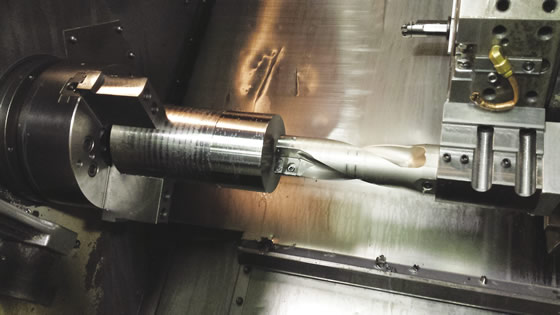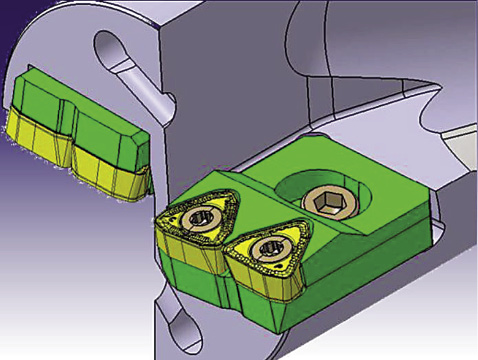Job shop likes ‘scream-free’ drilling
Job shop likes ‘scream-free’ drilling
Eliminate unpredictable and premature tool chipping and enhance consistency and chip control when drilling 304 stainless steel. An adjustable drill that accepts double-sided indexable inserts with six cutting edges.
END USER: DPI Inc., (215) 953-9800, www.dpicnc.com.
CHALLENGE: Eliminate unpredictable and premature tool chipping and enhance consistency and chip control when drilling 304 stainless steel.
SOLUTION: An adjustable drill that accepts double-sided indexable inserts with six cutting edges.
SOLUTION PROVIDERS: Tungaloy America Inc., (888) 554-8394, www.tungaloyamerica.com. Tri-State Industrial Supplies of PA Inc., (215) 340-1911, www.tristateofpa.com.
DPI Inc. is a job shop that specializes in making flanged cylinders. One ongoing job requires drilling a 3.150" (80.01mm) hole in 304 stainless steel 4½" (114.3mm) deep on its Hitachi Seiki 25G 2-axis lathe and then flipping the part to drill a hole with the same dimensions from the other side and achieve a concentricity and diameter tolerance of ±0.005" (0.127mm).
The task of drilling the difficult-to-machine material was compounded when DPI experienced unpredictable and premature tool chipping, uncontrollable chips wrapping around the drill and inconsistent horsepower draw during drilling, explained Lance Zeitz, vice president of operations and foreman for the Huntingdon Valley, Pa., shop. He added that the horsepower fluctuated by about 20 percent, which caused the indexable-insert drill to impart a rough surface finish and shortened insert life. It also made holding size a challenge and, therefore, required leaving extra material for finish boring.
The machining parameters were a cutting speed of 400 sfm (121.9 m/min.) and a feed from 0.0030 to 0.0040 ipr (0.076 mm/rev. to 0.102 mm/rev.), depending on the material heat lot.
Seeking a solution, Zeitz consulted with Leo Fitzpatrick, a salesman at distributor Tri-State Industrial Supplies of PA Inc., New Britain, Pa. Fitzpatrick felt confident that Tungaloy Corp. offered a drill to do the job but the Japan- headquartered toolmaker was not going to release the drill in the size DPI needed for 9 months. "I waited 9 months and bought the first four cartridges they brought into the country," Zeitz said.

A TungDrillBig drill tooled with TungSix-Drill inserts from Tungaloy prepares to cut a 304 stainless steel workpiece at DPI.
Albert Anelli, regional sales engineer for Tungaloy America Inc., Arlington Height, Ill., added that he needed to "beg, borrow and get creative to make sure Lance got what he needed to outfit his shop first."
The drills for large-diameter holes are from the TungDrillBig series, which have new replaceable cartridges to accept TungSix-Drill WWMU-type indexable inserts with six cutting edges. The cartridges are also adjustable, enabling any of the five available tool bodies to produce multiple hole sizes.
For the 304 stainless application, DPI applies a 3.0" (76.2mm) drill, offset to 3.150" (80.01mm), at a cutting speed of 660 sfm (201.17 m/min.) and a feed rate of 0.0048 ipr (0.1219 mm/rev.), or 3.84 ipm (97.54 mm/min.). The speed is the maximum surface footage Tungaloy recommends. Although the maximum recommended feed is 5.0 ipm (127 mm/min.), DPI runs slightly lower during production to ensure chips don't wrap around the tool or overload the conveyor, Zeitz noted. "We tested it at up to 0.0055 ipr and the drill took it."
Establishing those parameters for production holemaking was quick and painless, Zeitz said. "This drill is plug-and-play. With other drills I've had, it takes time to adjust them and get the speed, feed and offset to where they run best."
Compared to producing about 30 holes before indexing an insert with the previous drill, DPI can drill up to 100 holes, or 450" (11,430mm) of material, per edge with the new tool, Zeitz said. "I'm indexing the insert before it needs to be until I get more of a track record." The longer tool life is because chipping is not a problem for an insert's chamfered center edge at the drill center, where the cutting speed is zero, he added. "This drill has an extremely innovative insert design, which solved the problem. It's really an excellent piece of engineering."
DPI doesn't peck when applying the TungDrillBig drill, and, regardless of the brand of carbide drill, Zeitz doesn't recommend pecking because it shortens tool life when the hard, brittle cutting edges repeatedly enter and exit the cut. Nonetheless, he noted operators have a tendency to change the program and peck to prevent chip wrapping, particularly when drilling copper but also when making holes in stainless. That's understandable because it can take a couple minutes to remove the chips using a chip hook after machining a part.

Tungaloy's TungDrillBig drill body accepts TungSix-Drill indexable inserts with six cutting edges, and its diameter can be adjusted with the use of setting plates.
To enhance chip evacuation, the Tungaloy drill bodies supply coolant directly to the cutting edge, according to the toolmaker. "The coolant is ported right where it's supposed to be," Zeitz added, noting the lathe supplies coolant at 40 psi (2.76 bar). "In these larger holes, it's more about volume than pressure."
Zeitz appreciates that all four pockets in the drill accept the same insert instead of one insert for an inside pocket and another for an outside pocket. The only difference is the cutting edge on the outside insert wears a bit faster because it removes more metal. He added that the chip shape varies, depending on insert location. The center insert generates tightly curled chips, the outside insert produces chips with kinks and chips from the two inboard inserts flow like ribbons.
In addition, unlike when drilling with the previous tool, DPI sees minimal fluctuation in horsepower draw using the Tungaloy offering. This enables finishing the holes with four boring passes to achieve the ±0.002" (0.051mm) concentricity and size tolerances and impart a 16-rms finish on a thin wall.
An additional advantage of the TungDrillBig can be heard—or rather not heard. "The drills I used in the past would scream," Zeitz said. "We would push them until you needed to wear earplugs. Jose Prunes, the setup guy and operator, said, 'This drill is stealth.' It makes for much better shop conditions. Another advantage to the Tungaloy drill is when something goes wrong, such as chips building up, the drill holds up compared to previous drills, which melted and were unusable."

